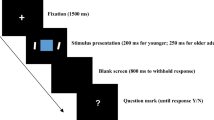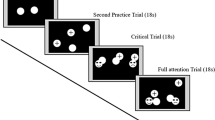Abstract
Most work on emotional attention in aging has focused exclusively on stimulus valence, with very few studies systematically examining how younger and older adults may differ in their attention to emotional stimuli that varies by both valence and arousal. This could be potentially important when evaluating early attentional processes, as previous work has shown that attention to positive and negative content is similar when levels of arousal are equivalent. In the current study younger (n = 48) and older (n = 49) adult participants completed a spatial cueing task in which they responded to the location of a spatial target that was preceded by an emotional image cue. Results indicated that both younger and older adults took longer to disengage attention from highly arousing image cues regardless of valence. These results demonstrate a context in which typical age-related positivity effects do not emerge, highlighting the importance of evaluating different attentional processes when studying emotional attention and taking stimulus arousal into account.

Similar content being viewed by others
Notes
A sensitivity analysis revealed 90% power to detect medium-large (d = .64) and 80% power to detect medium (d = .56) between-subjects (i.e., age) effects.
Analyses were also conducted using the YA RT cutoffs for all participants and produced consistent results (see Appendix C).
When a full arousal model was tested, no significant interactions between age and arousal on orientation trials γ = -6.81, SE = 4.80, t(14,734) = -1.42, p = .16 or disengagement trials γ = 3.54, SE = 8.91, t(14,734) = 0.40, p = .69, were found (see Appendix D for arousal model).
We are interpreting bayes factors following Lee and Wagenmakers (2013) where a BF10 greater than 3 is considered moderate evidence for the alternative hypothesis over the null, and a BF10 less than 0.3 is considered moderate evidence for the null hypothesis over the alternative.
References
Aquino, J. M., & Arnell, K. M. (2007). Attention and the processing of emotional words: Dissociating effects of arousal. Psychonomic Bulletin & Review, 14(3), 430–435.
Bacon, W. F., & Egeth, H. E. (1994). Overriding stimulus-driven attentional capture. Perception & Psychophysics, 55(5), 485–496.
Calvo, M. G., Nummenmaa, L., & Hyönä, J. (2008). Emotional scenes in peripheral vision: Selective orienting and gist processing, but not content identification. Emotion, 8(1), 68.
Cashdollar, N., Fukuda, K., Bocklage, A., Aurtenetxe, S., Vogel, E. K., & Gazzaley, A. (2013). Prolonged disengagement from attentional capture in normal aging. Psychology and Aging, 28(1), 77.
Charles, S. T. (2010). Strength and vulnerability integration: A model of emotional well-being across adulthood. Psychological Bulletin, 136(6), 1068.
Cona, G., Bisiacchi, P. S., Amodio, P., & Schiff, S. (2013). Age-related decline in attentional shifting: Evidence from ERPs. Neuroscience Letters, 556, 129–134.
Demeyer, I., Sanchez, A., & De Raedt, R. (2017). Older adults’ attentional deployment: Differential gaze patterns for different negative mood states. Journal of Behavior Therapy and Experimental Psychiatry, 55, 49–56.
Fan, J., McCandliss, B. D., Sommer, T., Raz, A., & Posner, M. I. (2002). Testing the efficiency and independence of attentional networks. Journal of Cognitive Neuroscience, 14(3), 340–347.
Folk, C. L., & Hoyer, W. J. (1992). Aging and shifts of visual spatial attention. Psychology and Aging, 7(3), 453.
Folstein, M. F., Folstein, S. E., & McHugh, P. R. (1975). “Mini-mental state”: A practical method for grading the cognitive state of patients for the clinician. Journal of Psychiatric Research, 12(3), 189–198.
Fox, E., Russo, R., & Dutton, K. (2002). Attentional bias for threat: Evidence for delayed disengagement from emotional faces. Cognition & Emotion, 16(3), 355–379.
Gross, J. J., & John, O. P. (2003). Individual differences in two emotion regulation processes: Implications for affect, relationships, and well-being. Journal of Personality and Social Psychology, 85(2), 348.
Joy, S., Kaplan, E., & Fein, D. (2004). Speed and memory in the WAIS-III Digit Symbol—Coding subtest across the adult lifespan. Archives of Clinical Neuropsychology, 19(6), 759–767.
Kappes, C., Streubel, B., Droste, K. L., & Folta-Schoofs, K. (2017). Linking the Positivity Effect in Attention with Affective Outcomes: Age Group Differences and the Role of Arousal. Frontiers in Psychology, 8, 1877.
Keil, A., & Freund, A. M. (2009). Changes in the sensitivity to appetitive and aversive arousal across adulthood. Psychology and Aging, 24(3), 668.
Kennedy, B. L., Huang, R., & Mather, M. (2019). Age differences in emotion-induced blindness: Positivity effects in early attention. Emotion, 20(7), 1266–1278.
Kirk, B. A., Schutte, N. S., & Hine, D. W. (2008). Development and preliminary validation of an emotional self-efficacy scale. Personality and Individual Differences, 45(5), 432–436.
Kurdi, B., Lozano, S., & Banaji, M. R. (2017). Introducing the open affective standardized image set (OASIS). Behavior Research Methods, 49(2), 457–470.
Lang, P. J., Greenwald, M. K., Bradley, M. M., & Hamm, A. O. (1993). Looking at pictures: Affective, facial, visceral, and behavioral reactions. Psychophysiology, 30(3), 261–273.
Lee, M. D., & Wagenmakers, E.-J. (2013). Bayesian cognitive modeling: A practical course. Cambridge University Press.
Livingstone, K. M., & Isaacowitz, D. M. (2019). Age similarities and differences in spontaneous use of emotion regulation tactics across five laboratory tasks. Journal of Experimental Psychology: General, 148(11), 1972.
Mather, M., & Knight, M. R. (2006). Angry faces get noticed quickly: Threat detection is not impaired among older adults. The Journals of Gerontology Series B: Psychological Sciences and Social Sciences, 61(1), P54–P57.
Most, S. B., Smith, S. D., Cooter, A. B., Levy, B. N., & Zald, D. H. (2007). The naked truth: Positive, arousing distractors impair rapid target perception. Cognition and Emotion, 21(5), 964–981.
Mroczek, D. K., & Kolarz, C. M. (1998). The effect of age on positive and negative affect: A developmental perspective on happiness. Journal of Personality and Social Psychology, 75(5), 1333.
Nezlek, J. B. (2011). Multilevel modeling for social and personality psychology. Sage.
Noh, S. R., Lohani, M., & Isaacowitz, D. M. (2011). Deliberate real-time mood regulation in adulthood: The importance of age, fixation and attentional functioning. Cognition & Emotion, 25(6), 998–1013.
Öhman, A., Flykt, A., & Esteves, F. (2001). Emotion drives attention: Detecting the snake in the grass. Journal of Experimental Psychology: General, 130(3), 466.
Pelli, D. G., Robson, J. G., & Wilkins, A. J. (1988). The design of a new letter chart for measuring contrast sensitivity. Clinical Vision Sciences, 2, 187–199.
Raudenbush, S. W., & Bryk, A. S. (2002). Hierarchical linear models: Applications and data analysis methods (Vol. 1). Sage.
Raudenbush, S. W., Bryk, A. S., & Congdon, R. (2013). HLM 7.01 for Windows (HLM Version 7) [Computer software]. Skokie, IL: Scientific Software International, Inc
Reed, A. E., Chan, L., & Mikels, J. A. (2014). Meta-analysis of the age-related positivity effect: Age differences in preferences for positive over negative information. Psychology and Aging, 29(1), 1.
Sands, M., Garbacz, A., & Isaacowitz, D. M. (2016). Just change the channel? Studying effects of age on emotion regulation using a TV watching paradigm. Social Psychological and Personality Science, 7(8), 788–795.
Sands, M., & Isaacowitz, D. M. (2017). Situation selection across adulthood: The role of arousal. Cognition and Emotion, 31(4), 791–798.
Schupp, H. T., Flaisch, T., Stockburger, J., & Junghöfer, M. (2006). Emotion and attention: Event-related brain potential studies. Progress in Brain Research, 156, 31–51.
Tales, A., Muir, J. L., Bayer, A., & Snowden, R. J. (2002). Spatial shifts in visual attention in normal ageing and dementia of the Alzheimer type. Neuropsychologia, 40(12), 2000–2012.
Vogt, J., De Houwer, J., Koster, E. H., Van Damme, S., & Crombez, G. (2008). Allocation of spatial attention to emotional stimuli depends upon arousal and not valence. Emotion, 8(6), 880.
Watson, D., Clark, L. A., & Tellegen, A. (1988). Development and validation of brief measures of positive and negative affect: The PANAS scales. Journal of Personality and Social Psychology, 54(6), 1063.
Wechsler, D. (1981). WAIS-R manual: Wechsler adult intelligence scale-revised. Psychological Corporation.
Weissman, M. M., Sholomskas, D., Pottenger, M., Prusoff, B. A., & Locke, B. Z. (1977). Assessing depressive symptoms in five psychiatric populations: A validation study. American Journal of Epidemiology, 106(3), 203–214.
Zhou, S. S., Fan, J., Lee, T. M., Wang, C. Q., & Wang, K. (2011). Age-related differences in attentional networks of alerting and executive control in young, middle-aged, and older Chinese adults. Brain and Cognition, 75(2), 205–210.
Funding
The authors did not receive support from any organization for the submitted work.
Author information
Authors and Affiliations
Corresponding author
Ethics declarations
Conflict of interest
The authors declare that they have no conflict of interest.
Consent to participate
Informed consent was obtained from all individual participants included in the study.
Ethical approval
All procedures performed in studies involving human participants were in accordance with the ethical standards of the institutional and/or national research committee and with the 1964 Helsinki declaration and its later amendments or comparable ethical standards.
Additional information
Publisher's Note
Springer Nature remains neutral with regard to jurisdictional claims in published maps and institutional affiliations.
Supplementary Information
Below is the link to the electronic supplementary material.
Rights and permissions
About this article
Cite this article
Ossenfort, K.L., Isaacowitz, D.M. Spatial attention to arousing emotional stimuli in younger and older adults. Motiv Emot 45, 790–797 (2021). https://doi.org/10.1007/s11031-021-09899-x
Accepted:
Published:
Issue Date:
DOI: https://doi.org/10.1007/s11031-021-09899-x




